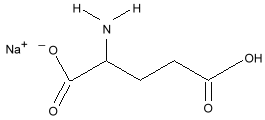Ingredients --
Monosodium glutamate
Chemical Formula:
 Monosodium glutamate
Monosodium glutamate
Synonyms
Sodium glutamate,
MSG,
L-glutamic acid, monosodium salt
Hydrolyzed vegetable protein
Autolyzed yeast
Whey protein
Description
White crystalline powder.
MSG is the sodium salt of the amino acid
glutamic acid.
It is made commercially by the fermentation of molasses, but
exists in many products made from fermented proteins, such as
soy sauce and hydrolyzed vegetable protein.
The tongue is sensitive to five flavors -- salt, sweet, bitter,
sour, and
umami, the taste of MSG.
Glutamic acid is a component of many proteins, such as those in
dairy products, meat, legumes, and mushrooms. However, only the
free form of glutamic acid or glutamates has an effect on the
glutamate receptors. When bound to other amino acids in a protein,
it does not stimulate glutamate receptors.
Free glutamate exist in certain cheeses (such as parmesan),
in tomato products, and in
soy sauce. These products are often used to enhance the flavor of
meat dishes.
Proteins can be hydrolyzed by heat, releasing free glutamates.
Cooked meats, especially grilled meats, get some of their taste
from free glutamates.
Uses
MSG is used to give a "meaty", "savory", or "brothy" taste to
foods by stimulating the glutamate receptors on the tongue.
There are glutamate receptors in other parts of the body, notably
the brain, where glutamate is a neurotransmitter.
Glutamates can be produced by fermentation of starches or sugars,
but also by breaking the bonds between amino acids in proteins,
leaving free amino acids. This process is done by heat or by
enzymes, and is called
hydrolyzing because the bonds are
broken by adding water.
When proteins are borken down into their constituent amino acids,
the result can contain as much as 20 percent glutamates. This is
why
hydrolyzed vegetable protein is often listed as an
ingredient in foods, to give them a meaty or savory flavor.
There is evidence that some people are sensitive to free glutamates,
and may get headaches or other symptoms if too much is ingested.
This may be related to pyridoxine (vitamin B6) deficiencies, as this
vitamin is necessary for glutamate metabolism. People with uncontrolled
severe asthma may find that it complicates or worsens their symptoms.
Bound glutamates in proteins are very common in food. Human breast
milk contains ten times as much as cow's milk, and tomato juice
contains 4 times as much as breast milk. However, free glutamate,
as found in soy sauce or prepared foods, enters the bloodstream
much faster than the glutamates bound in proteins, where they are
released slowly during digestion.
